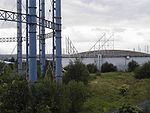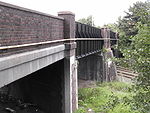
Swan Village Gas Works
Encyclopedia

Coal gas
Coal gas is a flammable gaseous fuel made by the destructive distillation of coal containing a variety of calorific gases including hydrogen, carbon monoxide, methane and volatile hydrocarbons together with small quantities of non-calorific gases such as carbon dioxide and nitrogen...
, or as it was known in the vernacular: 'town gas'. The works are situated in Swan Village
Swan Village
Swan Village is a village, now part of West Bromwich, England.It is now divided by the Black Country New Road and was the site of the Swan Village Gas Works. Nearby was the junction of the Ridgacre Branch with the Wednesbury Old Canal, both now disused....
, a part of West Bromwich
West Bromwich
West Bromwich is a town within the Metropolitan Borough of Sandwell, in the West Midlands, England. It is north west of Birmingham lying on the A41 London-to-Birkenhead road. West Bromwich is part of the Black Country...
in the metropolitan borough of Sandwell
Sandwell
Sandwell is a metropolitan borough of the West Midlands with a population of around 289,100, and an area of . The borough is named after Sandwell Priory, and spans a densely populated part of both the Black Country, and the West Midlands conurbation, encompassing the urban towns of Blackheath,...
. Most of the works have been demolished although a few relics survive. Parts of the works are still in operation today as part of the National Grid.
History

Birmingham
Birmingham is a city and metropolitan borough in the West Midlands of England. It is the most populous British city outside the capital London, with a population of 1,036,900 , and lies at the heart of the West Midlands conurbation, the second most populous urban area in the United Kingdom with a...
and a number of surrounding towns, including West Bromwich; the lighting of the main road through the town was also mentioned in the Act. The Old Works (as seen on the map) were the first part of the complex to be constructed, and when completed in 1829 were the largest in the country.
Coal
Coal
Coal is a combustible black or brownish-black sedimentary rock usually occurring in rock strata in layers or veins called coal beds or coal seams. The harder forms, such as anthracite coal, can be regarded as metamorphic rock because of later exposure to elevated temperature and pressure...
was originally delivered to the Old Works by the Ridgacre Canal
Ridgacre Branch
The Ridgacre Branch is a canal branch of the Wednesbury Old Canal, part of the Birmingham Canal Navigations, in the West Midlands, England....
, with a basin connected to the canal
Canal
Canals are man-made channels for water. There are two types of canal:#Waterways: navigable transportation canals used for carrying ships and boats shipping goods and conveying people, further subdivided into two kinds:...
constructed to allow the loading and unloading of coal barges. Eventually the railway arrived in 1854 with the opening of the Great Western Railway's
Great Western Railway
The Great Western Railway was a British railway company that linked London with the south-west and west of England and most of Wales. It was founded in 1833, received its enabling Act of Parliament in 1835 and ran its first trains in 1838...
Birmingham to Wolverhampton line. Swan Village Station
Swan Village railway station
Swan Village railway station was an intermediate station on the Great Western Railway's Birmingham Snow Hill-Wolverhampton Low Level Line. It was opened in 1854. It was the last station before the Dudley Branch of the line diverged from the main line. The Dudley branch closed in 1964 as part of the...
was situated on the line, next to the works. From the station branched the Great Bridge line linking up with the South Staffordshire Line
South Staffordshire Line
The South Staffordshire Line was a railway line that connected Lichfield in Staffordshire, England with Dudley, formerly in Worcestershire. However, it joined the Oxford, Worcester and Wolverhampton Railway's line just north of Dudley Station, where it, in essence, continued to Stourbridge, in...
which ran to Dudley
Dudley
Dudley is a large town in the West Midlands county of England. At the 2001 census , the Dudley Urban Sub Area had a population of 194,919, making it the 26th largest settlement in England, the second largest town in the United Kingdom behind Reading, and the largest settlement in the UK without...
. The Swan Village Basin line also branched off just before the station at Swan Village that fed into the works. This line was solely used for freight transportation only.
With the railways in place, more gas production was possible, thus lowering the price of gas for consumers. Canal traffic diminished as a result. The photograph
Photograph
A photograph is an image created by light falling on a light-sensitive surface, usually photographic film or an electronic imager such as a CCD or a CMOS chip. Most photographs are created using a camera, which uses a lens to focus the scene's visible wavelengths of light into a reproduction of...
on the right shows the works with the Swan Village Basin line feeding into the complex. The gas holder on the right still exists today, albeit being empty hence why it is missing height.
Over the years, changing working patterns and the increase in demand for gas following nationalisation in 1949 meant that the works needed to expand. A decision was made by the Gas committee of Birmingham City Council, and the New Works were opened in 1953. It was fortunate that surplus land bought a century and a quarter previously allowed for expansion. The increased rail traffic necessitated extensive new sidings outside the works to accommodate additional wagons.
With the discovery of natural gas
Natural gas
Natural gas is a naturally occurring gas mixture consisting primarily of methane, typically with 0–20% higher hydrocarbons . It is found associated with other hydrocarbon fuel, in coal beds, as methane clathrates, and is an important fuel source and a major feedstock for fertilizers.Most natural...
in the North Sea
North Sea
In the southwest, beyond the Straits of Dover, the North Sea becomes the English Channel connecting to the Atlantic Ocean. In the east, it connects to the Baltic Sea via the Skagerrak and Kattegat, narrow straits that separate Denmark from Norway and Sweden respectively...
during the 1960's, coal gas became a thing of the past. The development of the National Grid meant that delivering coal by railway was an out of date method, thus the Swan Village Basin line was removed. The Great Bridge line closed in 1964 as a result of the Beeching Axe
Beeching Axe
The Beeching Axe or the Beeching Cuts are informal names for the British Government's attempt in the 1960s to reduce the cost of running British Railways, the nationalised railway system in the United Kingdom. The name is that of the main author of The Reshaping of British Railways, Dr Richard...
with
Swan Village Station eventually facing closure in 1972.
Remains

The only remains of the Swan Lane Basin and Great Bridge railway lines are the extra gaps under the bridge on Bilhay Lane where the lines converged with GWR's Birmingham to Wolverhampton line, which still exists today as Line 1 of the Midland Metro
Midland Metro
The Midland Metro is a light-rail or tram line in the West Midlands of England between the cities of Birmingham and Wolverhampton via West Bromwich and Wednesbury. It is owned and promoted by Centro, and operated by West Midlands Travel Limited, a subsidiary of the National Express Group , under...
. Embankments around the site offer clues to the paths of the original railway. The construction of modern Swan Lane has obliterated any signs that a level crossing by the Old Loco Shed was ever there.
New buildings have been built on the site of the New Works in between the old gas holders, that operate as the Sandwell Station on the National Grid.

